Learn how to make fresh paneer at home with only a few simple ingredients. This easy homemade paneer recipe creates the softest, most tender paneer cheese from scratch – with no preservatives or special additives needed.
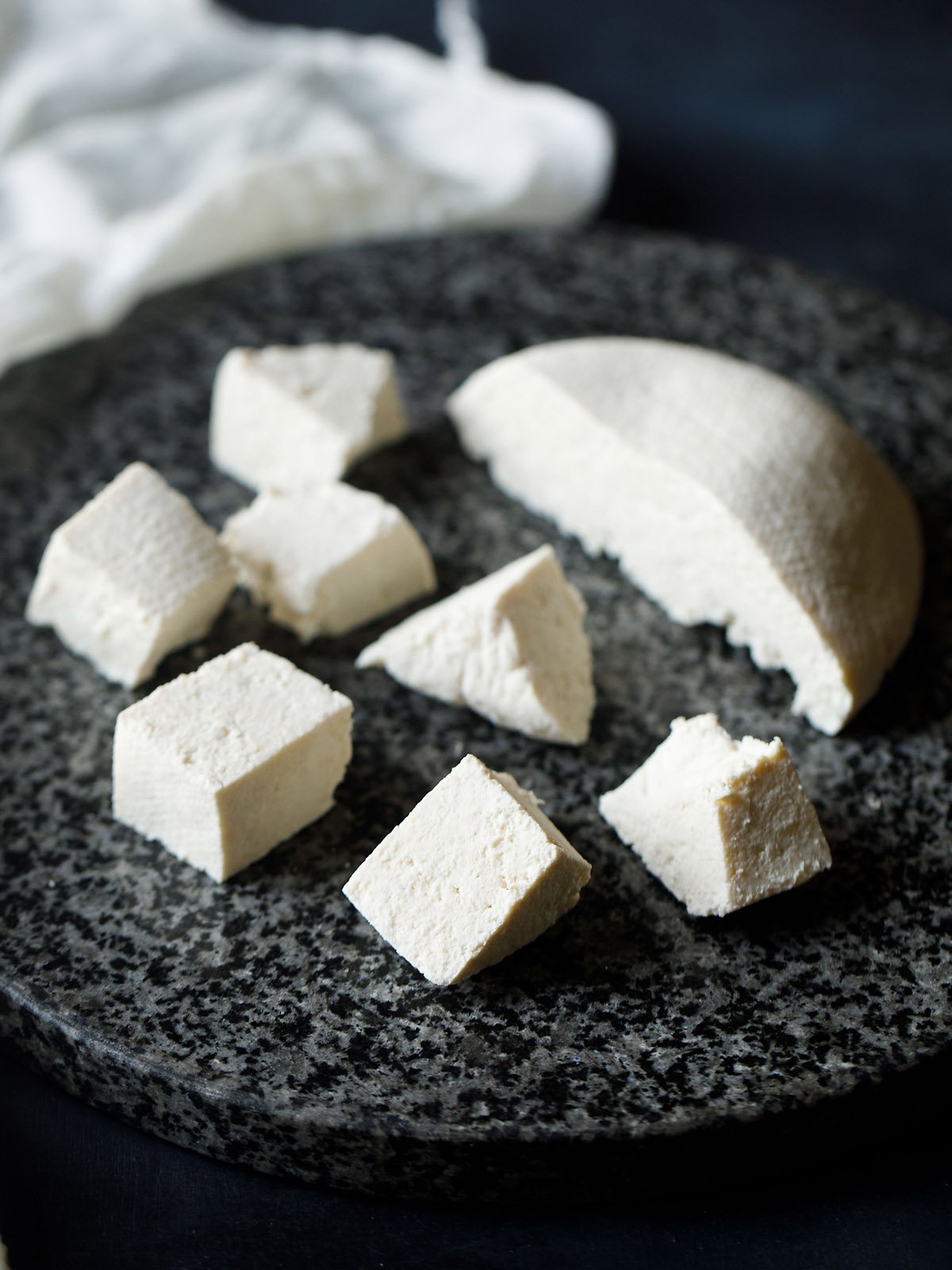
I have been making paneer from scratch for many years, and cannot remember the last time I bought it in a store. Not only is homemade paneer more wholesome and fresh, it is actually cheaper to make than it is to buy.
With just a few key steps and tips you too can make the best tasty paneer in your own kitchen!
What is Paneer?
Also known as Indian cottage cheese, paneer is a fresh cheese made by adding a food-based acid to curdled milk. The resulting whey is strained and pressed in muslin cheesecloth, creating a firm block of delicious cheese.
Paneer does not require any fermenting or curing. And unlike many other kinds of cheese in the world, the making of paneer does not involve Rennet, and it is therefore completely vegetarian-friendly.
It is a firm, non-melting cheese that is unsalted, and has a pleasantly mild flavor. Paneer cheese is made in a similar way ricotta cheese is made.
Blocks of homemade paneer can be used to make a variety of tasty dishes, from pakora to curries – and is super yummy to eat by the slice on its own!
About Homemade Paneer
I learned how to make paneer decades back in my cooking school. It is a simple process that involves first boiling milk and curdling with a food acid, then pressing to form a firm cheese.
The curdled milk is strained and pressed in cheesecloth, and the whey is either discarded or reserved for later use.
After just 30 minutes you have a beautiful homemade block of fresh homemade paneer that’s ready to keep in the fridge or use in your favorite dishes.
5 food acids that curdle milk
- Lemon juice or lime juice: Adding lemon juice gives a soft and firm texture to your homemade paneer. For a litre of milk you could add about 2 to 4 teaspoons of lemon juice depending on the quality of milk.
- Vinegar: A firm and soft texture is also achieved by adding vinegar. Add about 2 to 3 teaspoons of white vinegar or apple cider vinegar in 1 litre milk. With vinegar the milk curdles faster and quicker.
- Curd or yogurt: Fresh curd will give you more softer and moist paneer. You could add about 3 to 4 tablespoons of fresh curd or yogurt when making paneer recipe with 1 litre milk.
- Buttermilk: Using buttermilk also yields a soft as well as firm paneer cheese. Try adding 4 to 5 tablespoons of buttermilk in a litre of milk.
- Citric acid: I do not use citric acid as it create too firm of a cheese. But you can try it in combination with lemon juice or vinegar.
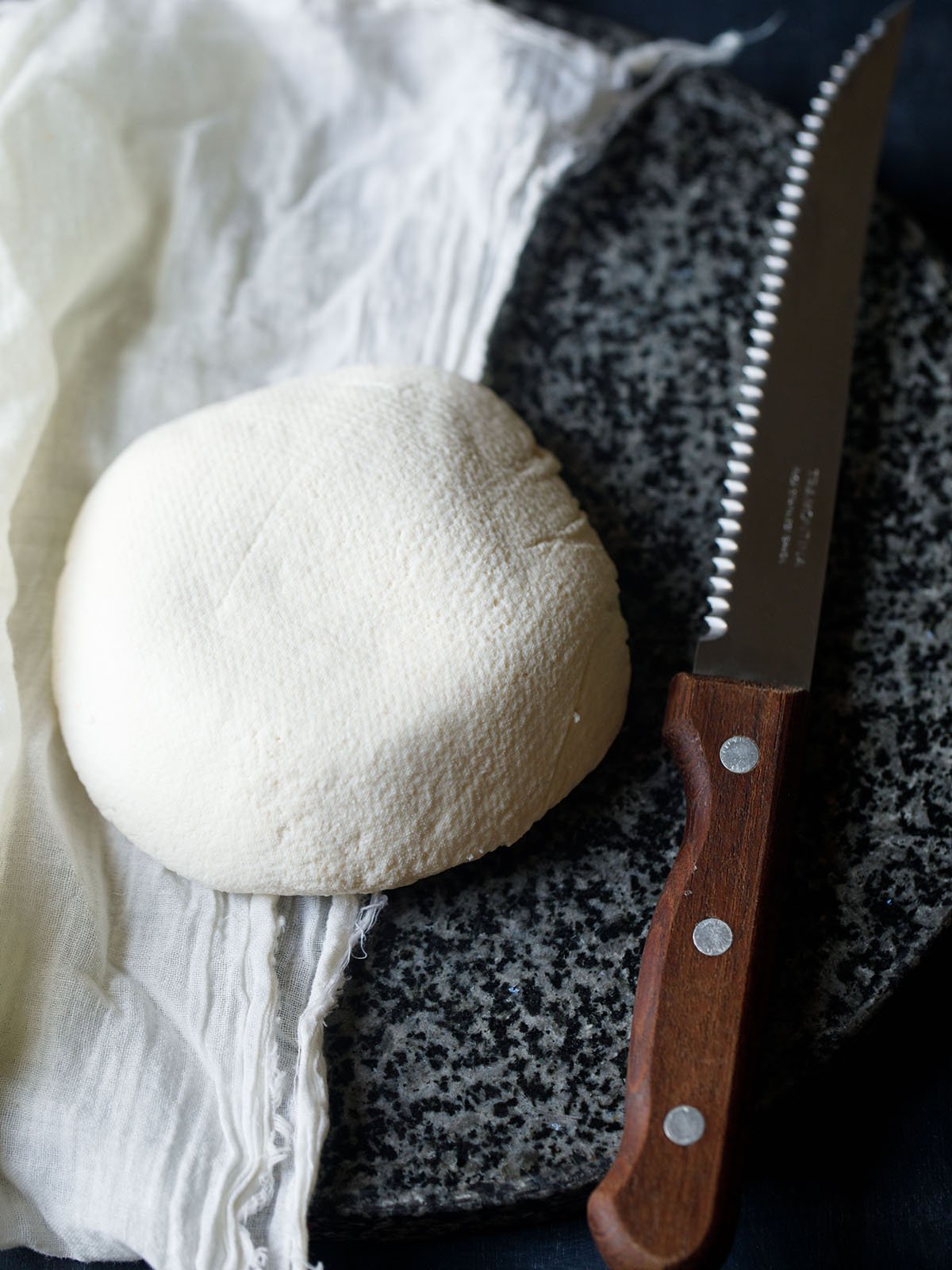
How to Make Paneer
Boiling the Milk
1. First, rinse a large, heavy duty pot with water to ensure that it is completely clean. Add 1 litre (approximately 4 cups) of milk to the pot.
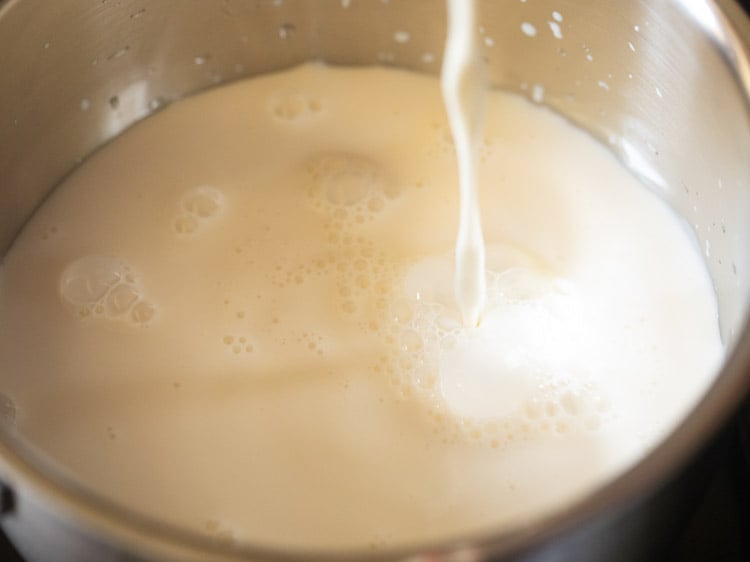
2. Then begin to heat the milk on a medium-low flame.
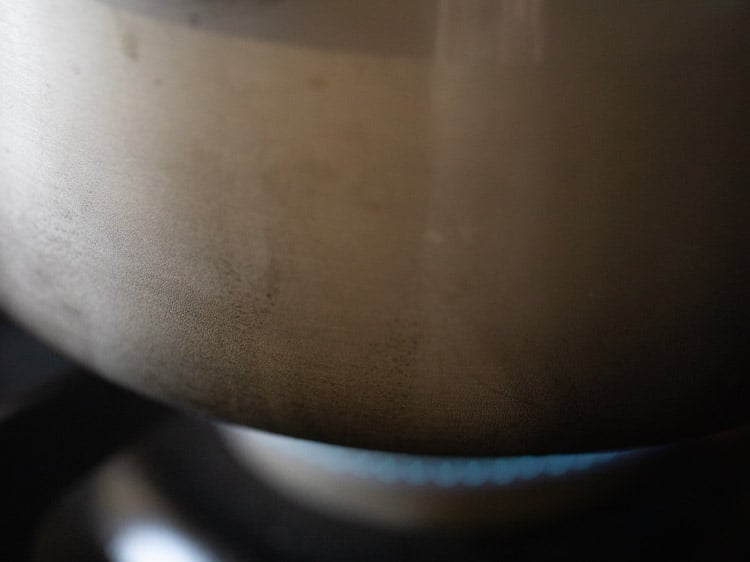
3. As the milk heats, stir occasionally so that a skin does not form on the surface and the milk does not burn on the bottom of the pot.
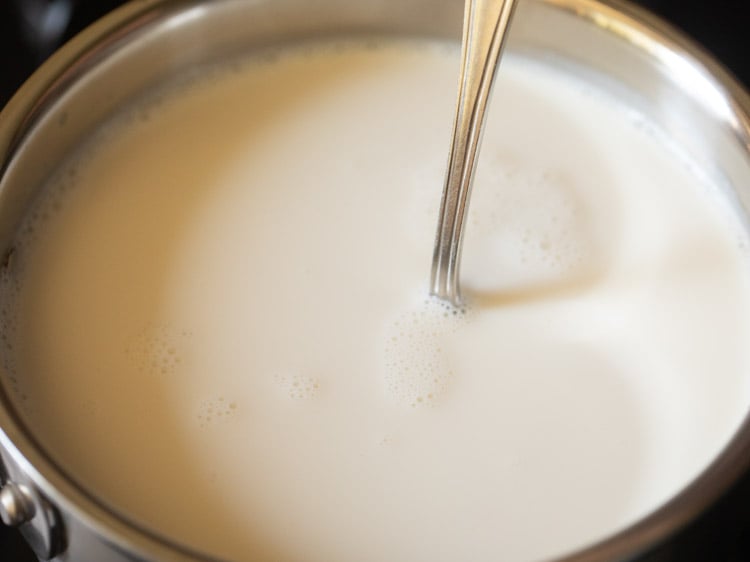
4. Meanwhile, prep your workspace: Place a metal strainer or sieve over another large sauce pot. Then line the strainer with clean muslin or cheesecloth, or a cotton napkin.
You can line the pan directly with the muslin, but using a strainer is very helpful for avoiding messes.
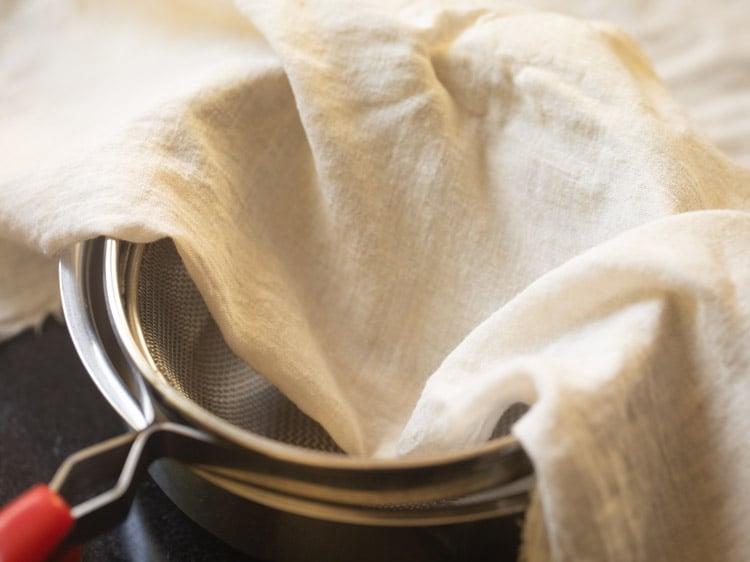
5. Let the milk come to a boil, until it starts foaming and rising.
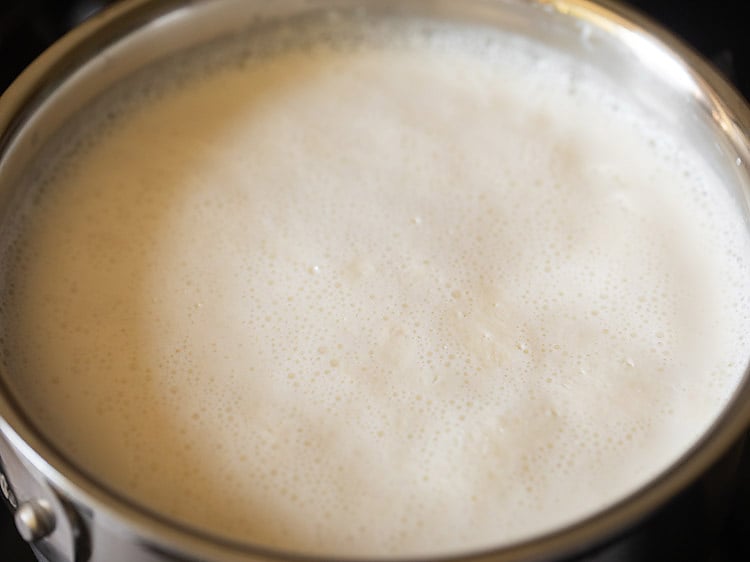
Adding Food Acid
6. Now it’s time to add the one food acid of your choice:
- Lemon juice – 2 to 4 teaspoons
- Vinegar – 2 to 3 teaspoons
- Buttermilk – 4 to 5 tablespoons
- Curd – at least 3 to 4 tablespoons
The amount of acid needed will depend on the quality of milk used. More fat in the milk will require more food acid to make this paneer recipe.
For this batch of paneer I am using lemon juice as the acid. It’s my favorite for its mild flavor and freshest tasting cheese.
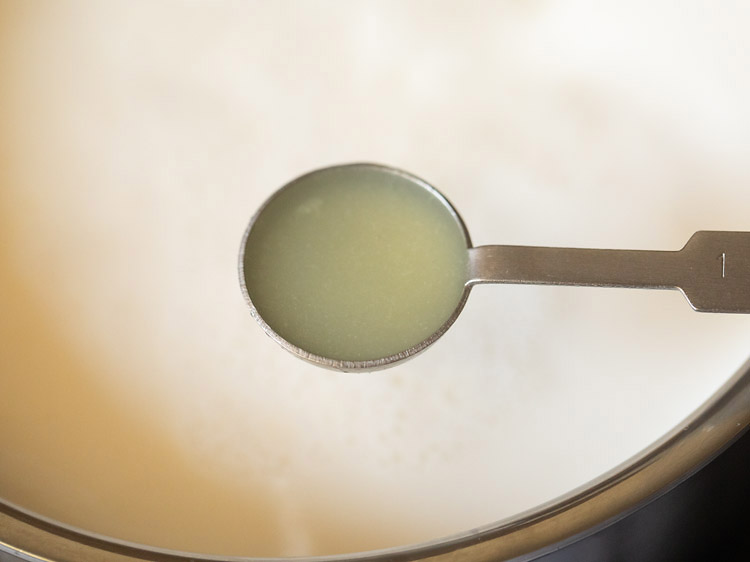
7. Stir in the lemon juice (or acid of choice). The milk will begin to curdle immediately.
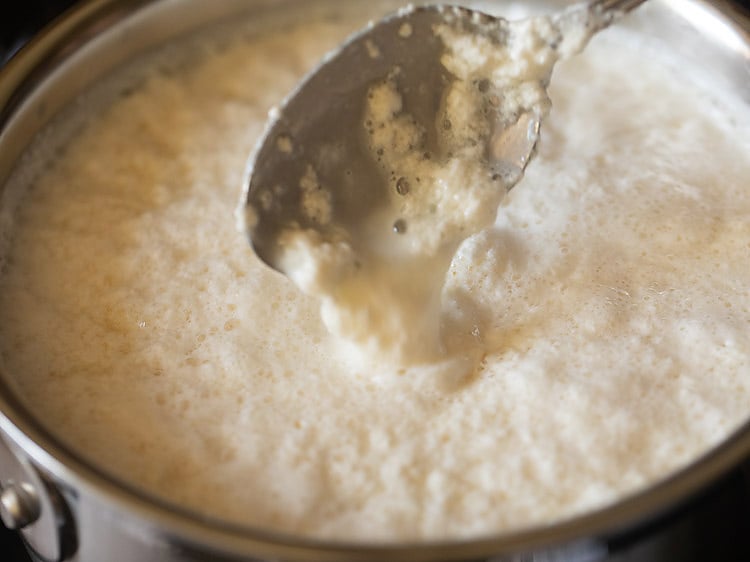
8. The milk must curdle completely before you can make paneer. Continue to stir the milk to help keep it from sticking to the pot.
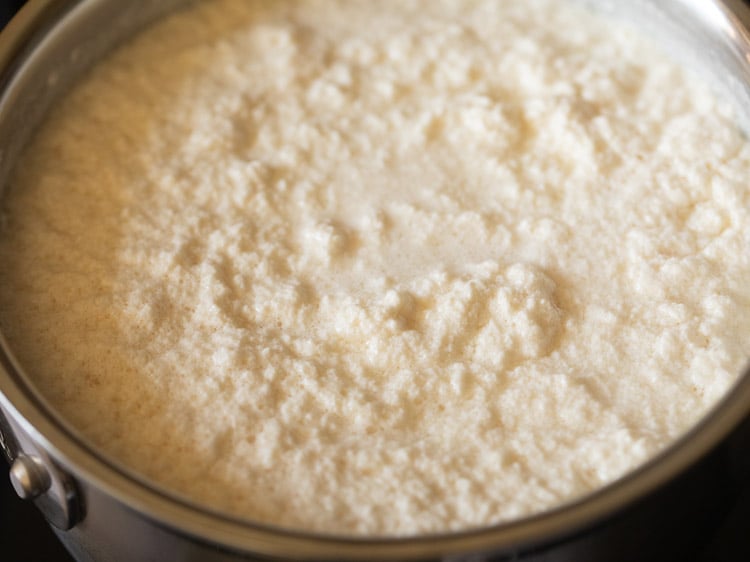
9. Add 1 to 2 teaspoons more of the food acid if it doesn’t seem to be curdling fully.
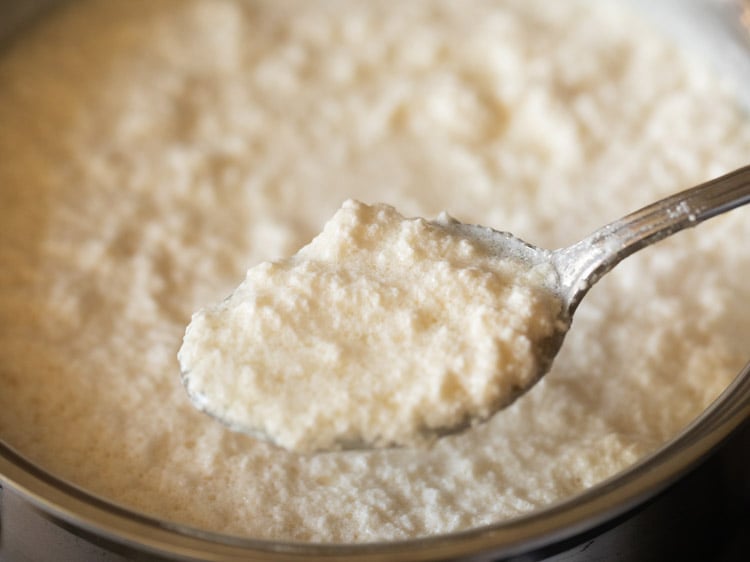
Making Homemade Paneer
10. After the milk has fully curdled completely and you see a greenish whey, switch off the heat. Then immediately pour the mixture into the lined strainer.
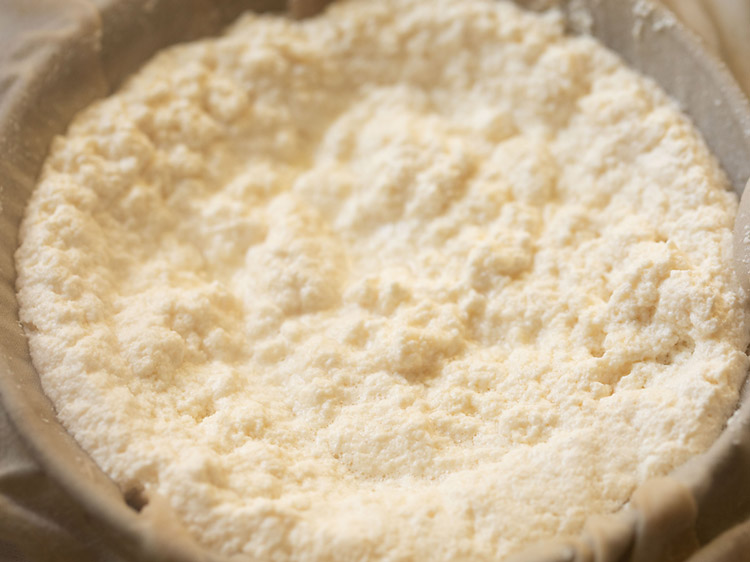
11. Next, gather the edges of the cheesecloth – be careful, the coagulated milk mixture will be very hot. Lift the bundle and allow to drain until no longer dripping.
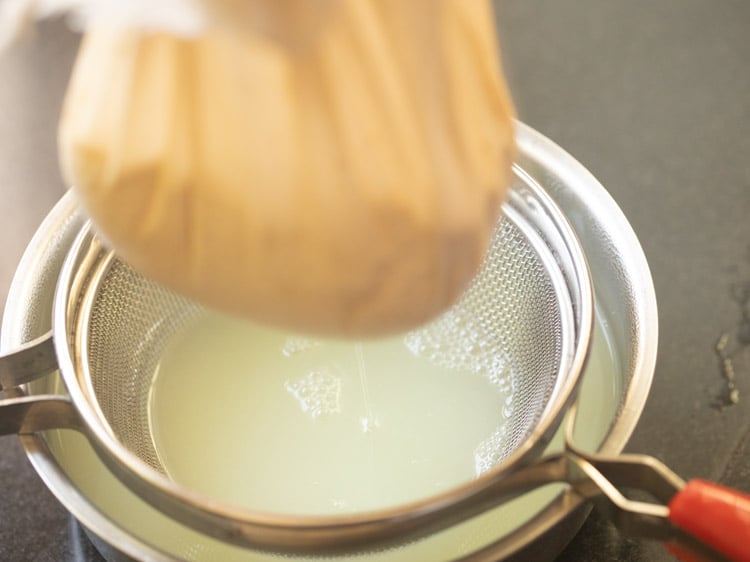
12. With the ends tightly gathered, run clean, fresh water all over the cloth to rinse. This ensures that the lemon or vinegar flavors are also rinsed with the water. If you have used curd or buttermilk, then you do not need to follow this step.
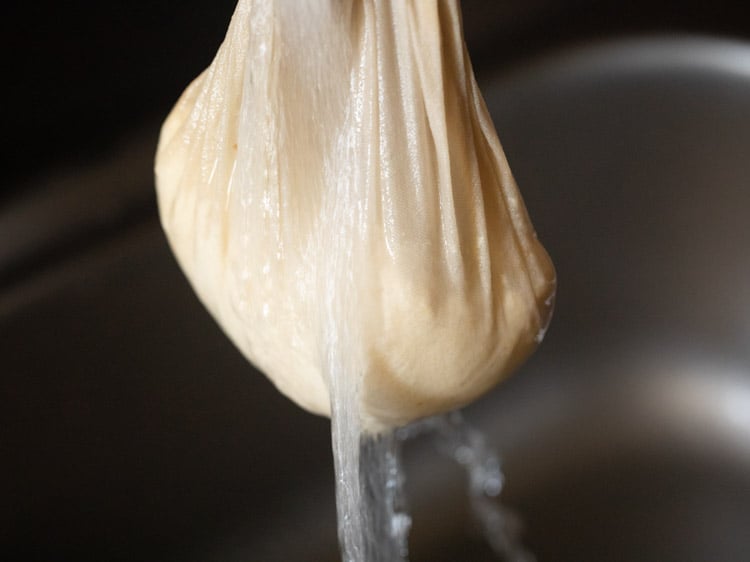
13. Tightly secure the ends of the cloth to keep the chenna wrapped, then place the bundle back in the strainer on a plate or over a clean bowl.
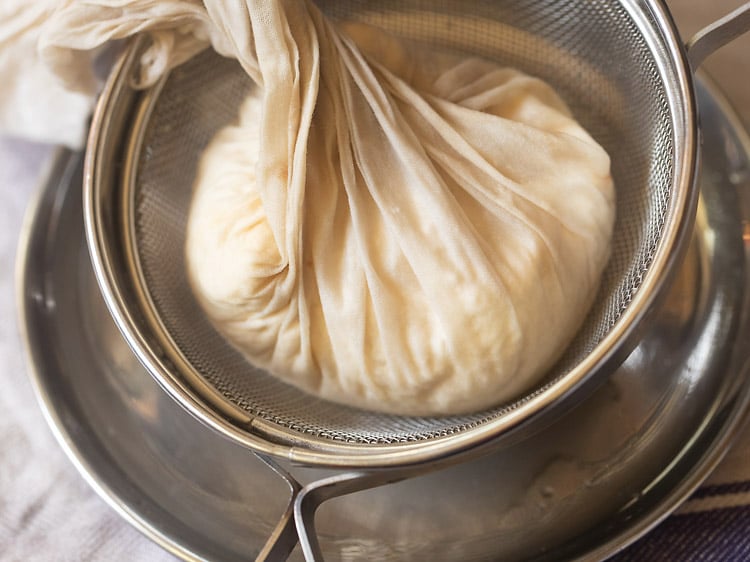
14. You can either hang the bundle (on your kitchen basin faucet) or press to form the cheese. Hanging the bundle will require about an hour, and should be done over a bowl or in your kitchen sink. This method tends to produce a softer, more loose texture.
I prefer to make a firmer paneer cheese by pressing the whey out with an object that weighs at least 500-600 grams (or at least 1 pound). This method only requires 30 to 40 minutes and can be done in the strainer over a pan or bowl.
In the picture below I’ve used the mortar from my mortar and pestle set. You could even stack up with some plates.
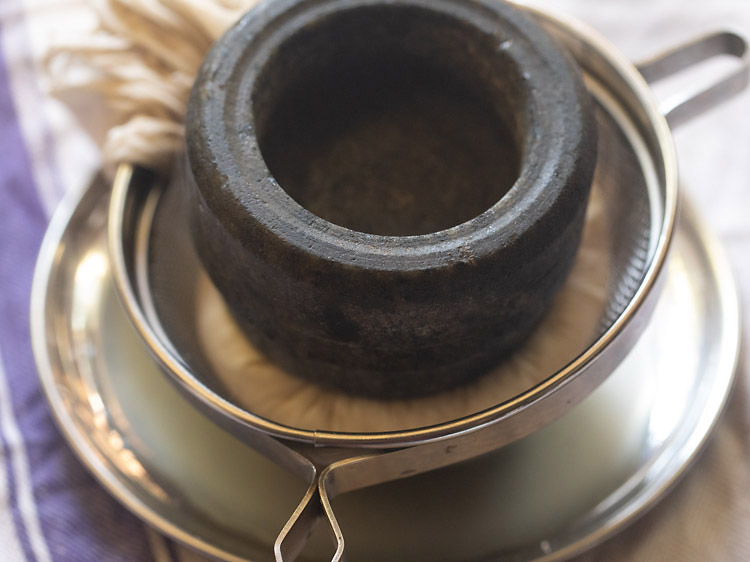
15. After 30 to 40 minutes of pressing the paneer is ready. The longer it sits with the weight the firmer your cheese will be. So for a softer cheese be sure to take off the weight sooner rather than later.
Remove the weight and open the cloth. I used one litre (4 cups) of milk and therefore made roughly 200 grams, or 7 ounces, of homemade paneer.
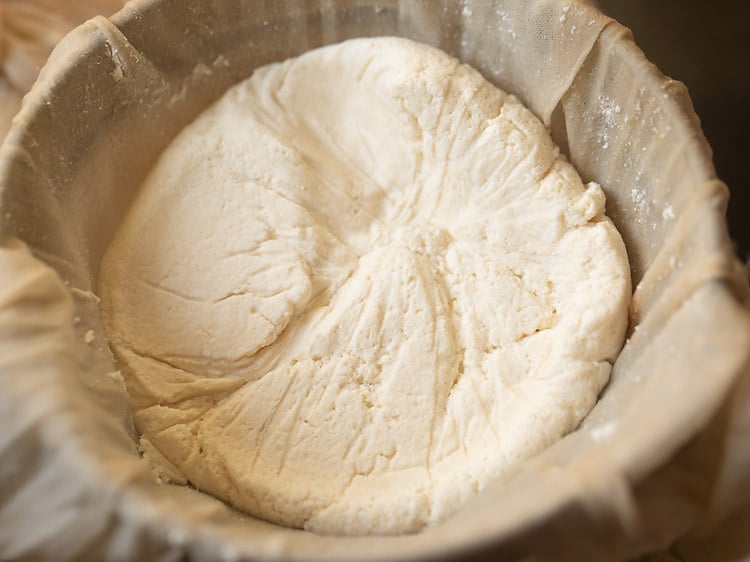
16. You now have a beautiful block of smooth and tender paneer cheese.
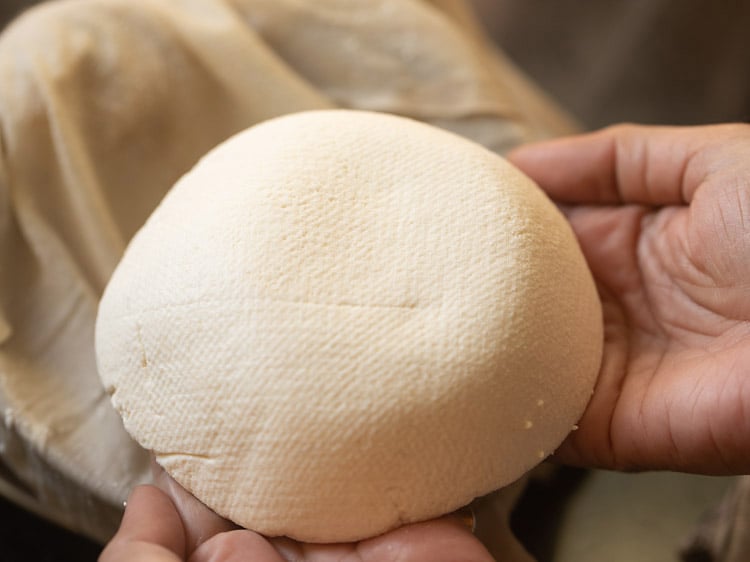
Storing and Using Paneer
17. Use the paneer right away to cook, or you can refrigerate it for later. To refrigerate, keep stored in an airtight container for 2 to 3 days.
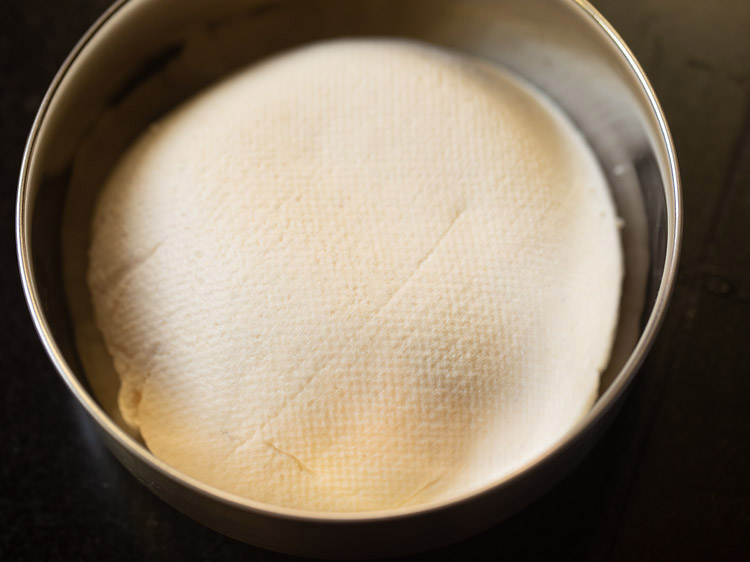
18. The collected whey can be added to roti, rice or vegetable dishes. Keep reading for some great ideas of what to do with the whey!
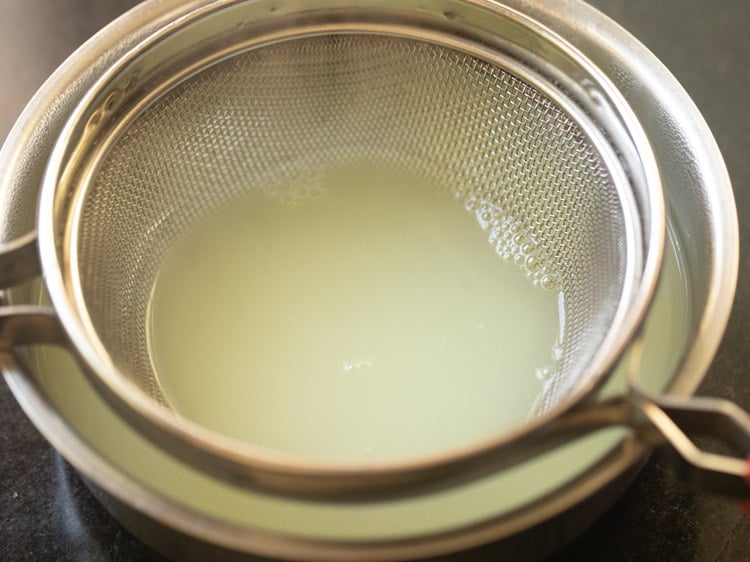
19. When ready to use the paneer, slice it thin or chop into chunks – whatever your recipe calls for. Try your fresh homemade paneer to make your favorite Indian curries or you can check my category of Paneer Recipes for more ideas.
You could also make Kadai Paneer, Palak Paneer, Paneer Butter Masala, Paneer Tikka, or any number of delicious recipes.
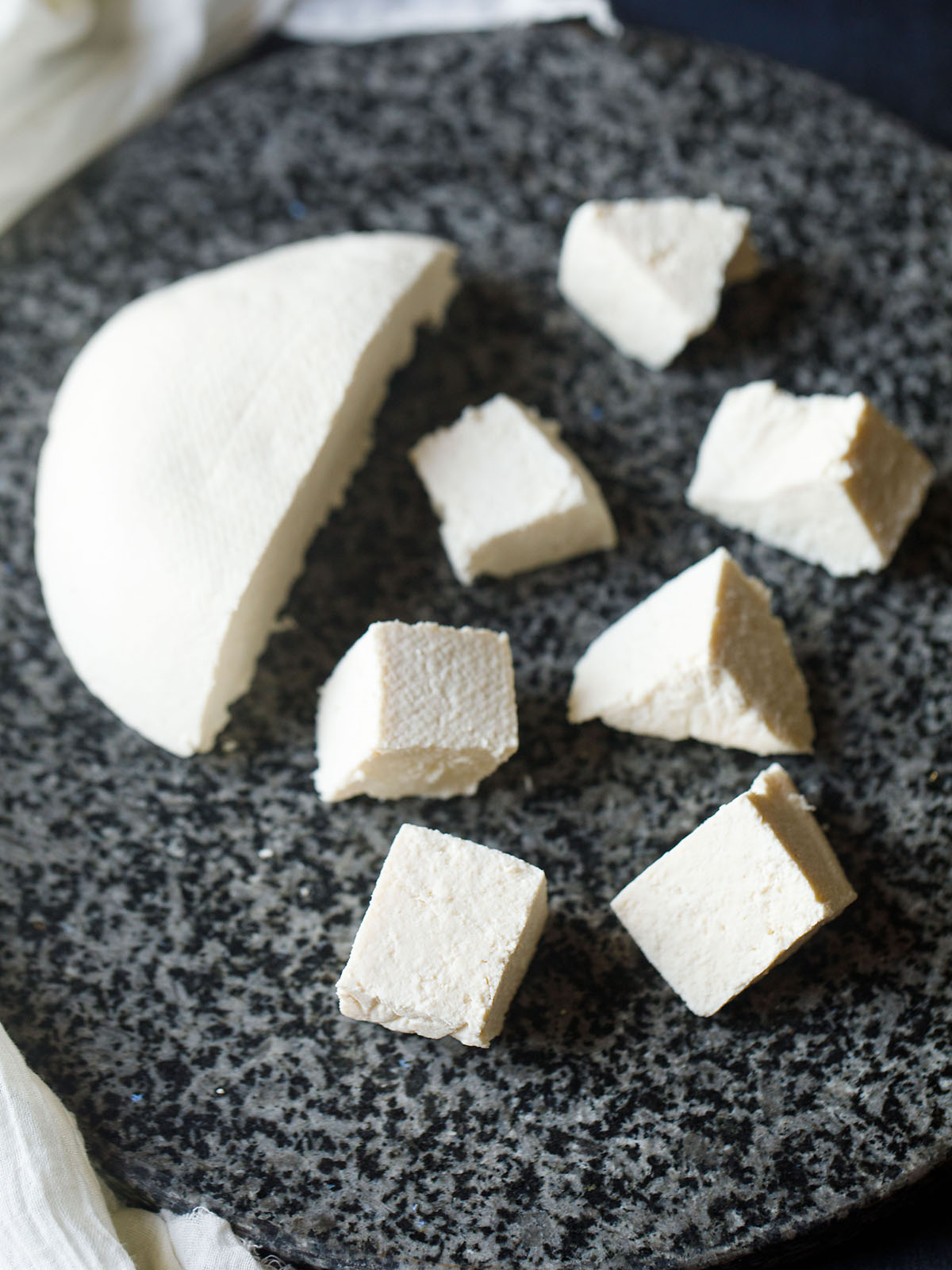
What to do with Leftover Whey
After pressing or hanging the paneer, you’ll have a greenish colored whey which is very rich in nutrients. You can discard this liquid, but I highly recommend you keep and use it for adding a healthy boost to a number of recipes. Easily refrigerate the whey for up to 5 days in an airtight container.
However, it should be noted that there will be a hint of flavor in the whey from whatever food acid agent is used. For example, if lemon juice has been used to curdle milk, there will be a bit of sourness in the whey and therefore any dish made with it.
Here are just a few ways to use the whey from the paneer-making process:
- Add nutrient-rich whey into the dough of breads like chapati, paratha, or any baked loaf of bread!
- Mix it into cake batters or cookie doughs.
- Include the whey in dals such as Dal Fry or Dal Tadka.
- Even Pulao and Biryani taste good with the whey added! If using to make veg biryani, add the whey in the vegetable gravy instead of water.
- Whey can be added raw into fruit smoothies, juices and even soups.
- It can also be added in any gravy or curry as a substitute for water.
- You can even make pasta based dishes with the whey!
- Because it is so rich in nutrients, you can even use it to nourish houseplants or garden plants! Simply cool and mix with water before watering your plants.
Expert Tips
Want to make sure your paneer is perfect every time? Be sure to follow my tips:
- Milk: For the tastiest paneer I recommend using full fat whole milk. Pasteurized or unpasteurized is fine, but it should be high quality for the best results. Do not use toned or skimmed milk for making paneer. Without lots of fat the paneer cheese will come out far too hard. Always use fresh milk that is not expired.
- Food acid: You can use any one of the four ingredients that coagulate the milk as mentioned above, but remember: each of these will add a hint of flavor to the paneer. Therefore use buttermilk or curd to make paneer with the most mild flavor.
- Cream: There is no need to remove any cream that you might see floating in the milk as it cooks. In fact, the natural cream present in the milk is what makes the paneer soft. Additionally you could add 2 to 3 tablespoons heavy cream in the milk before heating which will make for a more softer paneer.
- Simmering: Do not continue to boil the milk once it curdles completely. Immediately remove it from the heat and strain the milk. Otherwise, overcooking will yield an unpleasantly hard, crumbly cheese.
- Storing: Keep the paneer soft in the fridge by placing in a bowl and soaking the paneer block in water. If the paneer does become hard you can soak the block in warm water for a minute or two on the countertop.
FAQs
Firstly use whole milk or full fat milk when making paneer recipe. Paneer made with toned milk or skimmed milk or low fat milk breaks while cooking and does not set well. Do make sure that you drain the whey very well. Keeping paneer in the fridge also helps to firm it.
Freeze paneer for a month or two. While defrosting keep the paneer in warm water or let it defrost at room temperature. Yes paneer does work well after defrosting.
Yes, absolutely.
If there is more fat content in the milk, you will need to add more lemon juice to curdle it. So continue to add in parts and stir until you see that the entire milk has curdled.
If you continue to simmer the milk after it is curdled for some seconds or a minute, then the paneer becomes grainy and crumbly. Adding too much of lemon juice or vinegar will also make the paneer crumbly or granular.
Though they both look same and are made in a same way, they are different. Chenna is the coagulated milk shreds and paneer is the coagulated milk which has been set firmly. Chenna is more moist than paneer. You can check my Chenna Recipe.
If the right amount of lemon juice is added, it just takes some seconds for the milk to curdle.
Popular Recipes with Homemade Paneer
Paneer Recipes
Paneer Recipes
Paneer Recipes
Snacks Recipes
Please be sure to rate the recipe in the recipe card or leave a comment below if you have made it. For more vegetarian inspirations, Sign Up for my emails or follow me on Instagram, Youtube, Facebook, Pinterest or Twitter.
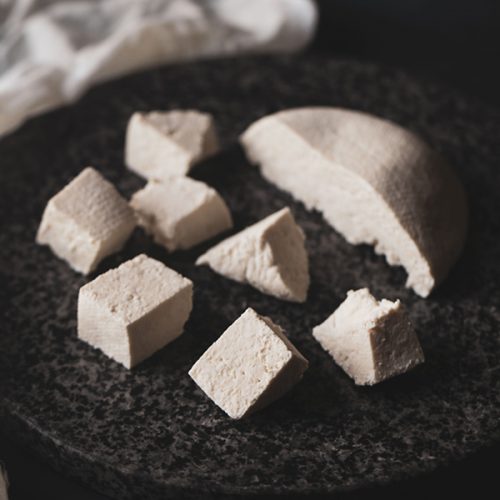
How to make Paneer at home from scratch
Ingredients
Ingredients
- 1 litre full fat whole milk
- 2 to 4 teaspoons lemon juice or vinegar or 3 to 4 tablespoons curd or yogurt
Materials required
- cheese cloth or muslin or a thin cotton napkin
- some bowls and a heavy weight object or plates
Instructions
Boiling milk
- First, rinse a large, heavy duty pot with water. Add milk to the pot.
- Then begin to heat the milk on a medium-low heat.
- Stir occasionally so that the skin does not form on the surface and also so that the milk does not get burnt from the bottom.
- Meanwhile, take a pan or a bowl. Place a strainer on the pan. Line the strainer with clean muslin or cheesecloth or cotton napkin. You can even line the pan directly with the muslin.
Adding food acid
- When the milk starts boiling, add the lemon juice or vinegar. Begin to stir.
- The milk has to curdle completely. Stir the milk when it is curdling so that the curdled milk does not stick to the base of the pan.
- Sometimes you will see the milk has curdled partly but no watery whey can be seen. In this case also add 1 to 2 teaspoons more of the food acid and stir again. You should see the greenish colored whey in the milk.
- After the milk has curdled completely and you see the greenish whey, switch off the heat and then immediately pour the entire mixture in the strainer lined with the muslin, cheesecloth or cotton napkin.
- Carefully gather the edges of the muslin as the coagulated milk mixture will be very hot. While doing this more of the whey will be strained.
- Run some clean fresh water on the gathered muslin all over.
Making paneer
- With the ends tightly gathered, run clean, fresh water all over the cloth to rinse.
- Keep a heavy weight on top of the muslin or cheesecloth for 30 to 40 minutes. Use a heavy object having 500 to 600 grams weight. You can even hang the muslin bundle for an hour on your kitchen basin faucet if not using a heavyweight object.
- Some more whey will be strained when you place the heavyweight object. So remove the whey from the plate.
- After 30 to 40 minutes the paneer will set.
- Once warm or cooled cut homemade paneer into cubes or any shape.
- You can also refrigerate the paneer. Keep it in an air tight container or immerse the paneer block in a bowl of water and keep in the fridge.
- Homemade paneer stays fresh for 2 to 3 days in the fridge in an air-tight container. You can slice the paneer cheese later and use it any recipe.
Video
Notes
- Milk: First and foremost use good quality milk. Again full fat whole milk yields excellent results just like it does for making homemade curd. You can use both raw milk or homogenized milk.
- Food acids: Three ingredients that coagulate the milk. You can use any one of them: Lemon juice, curd or vinegar. Each of these will add a faint hint to the paneer you make. Remember this. If you don’t like lemony or vinegar taste, add curd (yogurt) or buttermilk instead.
- Cream: If there is plenty of cream floating on top of milk surface, then there is no need to remove it. The natural cream present in the milk, makes the paneer cheese soft.
- Curdling milk: When you add the lemon juice or vinegar the milk will begin to curdle. The milk has to completely curdle. You should be able to see the whitish or greenish whey. When the milk has curdled completely then do not simmer or cook it further. Remove immediately and strain the milk. This overcooking will yield a hard paneer when it is set.
- Storing: Refrigerate paneer in an air-tight container for 2 to 3 days. Another way to keep the homemade paneer soft in the fridge is to soak the paneer block in water in a bowl and keep in the fridge. This way the paneer does not become hard. Alternatively you can soak the paneer in warm water after you have removed it from the fridge.
- Scaling: You could easily make a large block of paneer by doubling or tripling this recipe. When the paneer is set, chop them in cubes. Place them in an air-tight box and freeze. You can even refrigerate the paneer cheese for 2 to 3 days.
Nutrition Info (Approximate Values)
This homemade paneer recipe post from the archives first published in May 2012 has been updated and republished on November 2020.
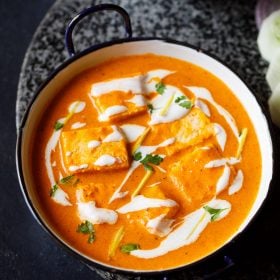
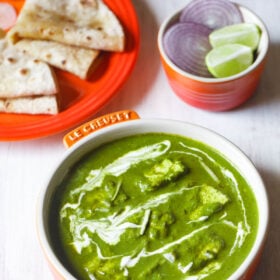
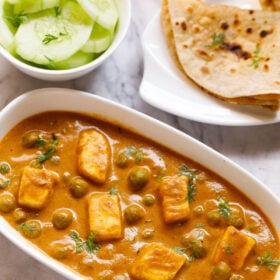
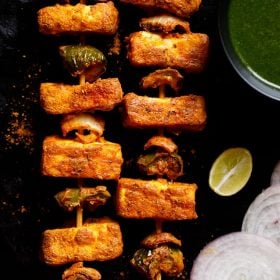

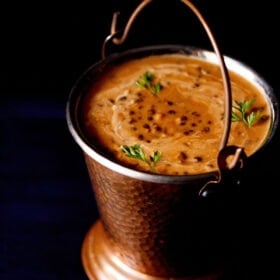
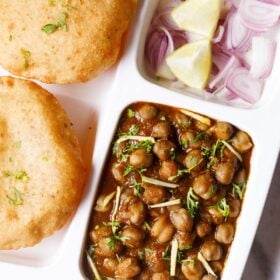








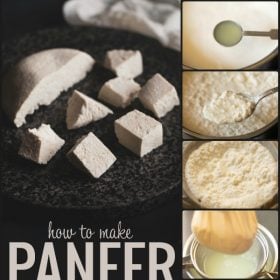
I used food grade 50% phosphoric acid to set my cheese. It has almost no flavor. For 500 ml of milk, I added 2.5ml acid. I have also tried 88% lactic acid and it works too. Still much more neutral than vinegar or lemon juice. Both those types of acids are sold at homebrew stores.
Just a tip – for those having trouble getting their milk to curdle, it could be the milk. The milk can be pasteurized, but avoid ultra-pasteurized, as the ultra-pasteurization process keeps the milk from curdling properly. Here in the US, the milk cartons are labeled, and I always make sure.
Also, I often use lime juice my acid. I think it leaves a wonderful flavor, depending on what I am using my paneer for.
I just found your blog today, and I am hooked! Thanks so much!!
welcome bonnie. thanks for sharing the tips. i am sure its going to help other readers. in india we get both raw milk and pasteurized milk. so the curdling happens easily.
Thank you for all the recipies ! It’s an amazing job that you are doing !
I have a question. Can I add little bit of curd and let’s say one teaspoon of lemon. I love when paneer is soft and that’s what I’m trying to do, to make it soft.
welcome pati. either add curd or lemon. curd you will have to add 2-3 tbsp or more to curdle the milk.
I would love to hear more about your uses for the leftover whey! Great recipes and instructions. Thank you.
thanks. i just add them to chapati doughs or to curries or dals.
Just tried this and it worked out great. Much better than paneer from supermarket in my opinion. Thanks for the recipe and clear instructions. Pictures were really helpful.
welcome lauren. thanks for this positive feedback. i agree homemade paneer is better than from super market.
It is very nice recipe. ..
Thanks for uploading. …
welcome.
Just made my first truly home made palak paneer curry and it tasted great. Thank you for sharing such great yet surprisingly simple knowledge which produces paneer so much nicer than supermarket bought! My only slight issue was yield, I ended up with about 150g from 1L of full fat fresh cows milk which still had a milky looking liquid remaining. From reading the instructions and the Q&A below, perhaps I was taking the milk off heat too soon? How long from putting the lemon juice into boiling milk would you say is maximum for getting a ‘full curdle’ without overcooking?
thanks a lot andy for your feedback. generally from 1 litre of milk, you can get about 200 to 250 gms of paneer. this depends on the quality of the milk. as you mention there was a milky looking liquid. which means that the milk has not curdled completely. the milk has to come to a complete boil. then you add the lemon juice. stir well and if the milk still does not curdle completely, then add some more lemon juice. generally the milk begins to curdle as soon as the lemon juice or vinegar is stirred in it.
I love paneer recipe. Thank you for this article and its really helpful.
thanks.
So happy to see my 1st homemade paneer block.sooo soft.
Thnx dassana.
welcome vibha
Hey Dassana,
Thanks for the easy instructions. I was wondering since both lemon juice and curd can be used, is there any difference with the texture of paneer that comes. I was confused with which one to use. Does lemon juice give a different texture as compared to curd?
with curd you get a bit softer texture in the paneer. plus with curd you won’t get the after taste if you add vinegar or lemon juice. depending on what you have, you can use any.
Can you also store the paneer in the whey, or would that toughen it?
generally paneer is not stored in the whey. not sure of the reason though. some people keep the set paneer in water in the refrigerator. this is so, so that the paneer stays moist.
Salam Dassana!
Sidra from Pakistan…I was looking for new and into the budget recepies…and I am happy that I clicked the very right place…I am really inspired by the way you guide the people…this honest try of yours reveals your enthusiasm to cooking…
God bless you for giving us the very best directions for cooking…I will be a regular visiter Inshallah….
thanks sidra. glad to know that you liked the blog and our love for cooking. big thanks for your blessings. keep visiting.
Hi dear dassana I’m so happy and surprised on seeing my paneer block. I could not believe my eyes. No one can explain clearly like u. Thank you so much. I became a big fan of you .
Welcome Dr.Saranya Vikram. keep visiting the site and try some recipes;.
Wow I made it
Thanks a lot Dassana
welcome sangita
Oh my. I made this tonight and cannot believe how easy it was to make delicious, soft paneer! Better than a lot of paneer I have eaten, in India and Australia. Thank you so much.
welcome alice. glad to know that you liked the method.